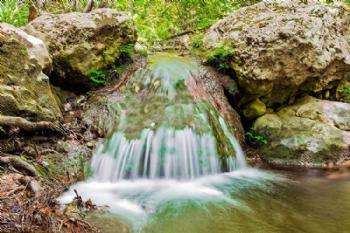
It is a water tunnel that used to be the middle section of a huge aqueduct named after its architect, Eupalinus who was a famous engineer of the ancient world. It is located on the mountain slopes of Panagia Spilani and was built in the 6th Century B.C during the reign of Polycrates.
Samos was at its peak of prosperity around this time and along with the Polycratean walls, the harbor mole and the Temple of Hera, the Tunnel of Eupalinus remains one of the most fascinating structures of Samos built during this period.
The construction of this tunnel took about ten years. It had two teams of laborers simultaneously working on either end. It is about 1.80 meters wide 1.80 meters high and 1350 meters long. About 7000 cubic meters of natural rock had to be removed in order to build this tunnel.
The tunnel is constructed with rectangular stones that are precisely placed one on top of the other. The roof is triangular in shape and is made up of the same kind of stones. Water flowed through ceramic pipes that were fitted in the aqueduct below the tunnel. Some of the pipes remain in pristine condition and almost look as though they were laid out just yesterday. The same water system was used for about a thousand years before being abandoned in the 7th Century A.D. It was rediscovered by Cyrillus Monina, a monk in 1882. It was eventually cleared out to be studied in detail by a group of German archaeologists between the years 1971-1973. Today it is well lit and open to visitors.
The Tunnel of Eupalinus bears testimony to the treasure of knowledge that the ancient Greeks possessed. It was definitely an admirable feat to build this tunnel at a time when technology was not as available or as advanced as it is today. What makes this structure even more fascinating is the sheer precision and skillfulness that went into creating this place. There is therefore little doubt as to why the Tunnel of Eupalinus never ceases to amaze both scientists and visitors alike.
